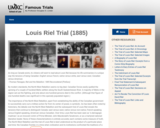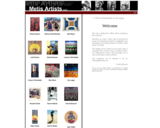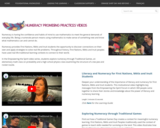
This site gives the background and information about a number of Inuit Games.
- Subject:
- Indigenous Perspectives
- Native Studies
- Social Studies
- Material Type:
- Activity/Lab
- Diagram/Illustration
- Game
- Author:
- University of Waterloo
- Date Added:
- 11/20/2018

This site gives the background and information about a number of Inuit Games.

'A Journey into Time Immemorial' is based on the story of Xá:ytem Longhouse in Mission BC in the Fraser Valley just east of Vancouver BC. Simon Fraser University worked closely with the staff at Xá:ytem to produce this award winning website. It is an artistic and cultural interpretation and is not meant to convey precisely accurate archaeological information. Contemporary archaeologists view First Nations as partners and value oral traditions as a source of information about the past that augments the scientific approach.

In this resource students will learn about the Kwakwaka’wakw (pronounced: kwock-KWOCKY-wowk) people of British Columbia, Canada. The focus is on Kwakwaka’wakw traditions that express concepts of wealth, values of giving, and the importance of cultural continuity. Students will learn about the Kwakwaka’wakw potlatch practice: its history, the values inherent in it, and the important role it plays in establishing and maintaining family connections to the past, to ancestors, and to the spirits of all living things. Students will use Kwakwaka’wakw concepts and discuss differences in value systems.

Find activities, games and stories for youth and educators about Indigenous peoples' culture, history and languages.

On this website you will find a comprehensive collection of documents, oral histories, newspapers, paintings, and photos that relate to the events of the 1864 war and the aftermath. You are invited to become an historian, to study the evidence and come to your own conclusions about the causes, outcomes and how the war has been understood through time. You will find other mysteries here too, not the least of which is, who was Klatsassin? The name means: "nobody knows him".

This site provides information on the 250-year relationship between Moravian missionaries and the Inuit of Labrador. This interaction led to the establishment of settlements for a formerly nomadic people, their conversion to Christianity and exposure to aspects of North American culture. The information has been gathered from a variety of sources that shed light upon this unique adventure.

The Legacy of Hope Foundation is a very comprehensive site that offers lots of great resources that help to promote healing and Reconciliation in Canada. The Legacy of Hope Foundation's (LHF) goal is to educate and raise awareness about the history and existing intergenerational impacts of the Residential School System (RSS) and subsequent Sixties Scoop (SS) on Indigenous (First Nations, Inuit, and Métis) Survivors, their descendants, and their communities to promote healing and Reconciliation.Check out each of the sections to see the great resources they have to offer.

Grade Level: 4–8 Time Required: Approximately 4 one-hour class periods and 2-3 homework sessions
OVERVIEW: Students learn about the oral culture and history-keeping of the Nakota people, who made the Lone Dog Winter Count. Then they create a monthly pictograph calendar of their own to document a year of their personal history.

As long as Canada exists, its citizens will want to read about Louis Riel because his life summarizes in a unique way the tensions of being Canadian: English versus French, native versus white, east versus west, Canadian versus American.
This site explores the famous trial of Louis Riel.

The Residential School story on Google Earth Voyager takes the reader to different locations across Canada that help put this traumatic history in geographical context.

The process of dealing with Aboriginal title and rights through formal agreements began shortly after contact was established between Europeans and First Nations peoples and has evolved over more than 300 years.
This site allows students to view maps illustrating the Pre-1975 Treaties of Canada, that were negotiated between 1725 and 1923. These treaties cover most of Ontario, the Prairie Provinces, parts of Vancouver Island, Northwest Territories and Atlantic Canada.

This site is dedicated to Metis artists working in the visual arts.
The links on the site were set up for information purposes to highlight some interesting work being produced by Metis visual artists in Canada.
The images & text found on each artists' page is excerpted from various sources available on-line. The sources have been indicated and you are encouraged to click on the links to those websites.

The resource was designed for anyone who teaches Mi’kmaw history, culture and knowledge. Through the stories and knowledge of Mi’kmaw Elders, educators, and other experts, this volume will share content and teaching strategies for three subject areas for grades primary to nine:
- Welo'ltimk—Healing
- Kejitasimkewey Kiskuk—Contemporary Issues
- Netukulimk—Economic, Social, and Political Life
The content and strategies are grouped into three age ranges, Primary to Grade 3, Grades 4 to 6, and Grades 7 to 9, with specific topics shown below. For each topic, educators will find: • core themes and issues • an opening activity(ies) • a core activity • extension activities • curriculum outcomes
The downloadable resource and companion materials offer the following lessons and activities:
Primary to Grade 3: Expressing Emotion, Mawio’mi (gathering), Msit No’kmaq (we are all related)
Grades 4 to 6: Diversity and Awareness, Treaties, Traditional Knowledge
Grades 7 to 9: Indian Residential School, Land Loss and Displacement, Netukulimk and Mi’kma’ki

My Cree App is like learning Cree from your Auntie!
You are going to love how quickly and easily you begin speaking Cree. And you can start learning to speak Cree, right on your own iPhone or iPad.

Roots of traditional Aboriginal worldviews teach that there are four interconnected parts to life including mental, physical, spiritual and emotional aspects. Looking at how culture exists also means looking into these four different, but symbiotic aspects of life. Today, the importance of understanding these aspects of culture are more broadly known and adopted. The United Nations Education, Scientific and Cultural Organization explains that
"...culture should be regarded as the set of distinctive spiritual, material, intellectual and emotional features of society or a social group, and that it encompasses, in addition to art and literature, lifestyles, ways of living together, value systems, traditions and beliefs..."
This archive article (University of Saskatchewan) will explore Métis culture from the perspective of a traditional Aboriginal worldview framework.

Nation to Nation takes a weekly look at the politics affecting Indigenous people in Canada.
Join us as we connect you with the decision-makers in Ottawa and across the country.

Canadian Teachers of grades 4-11 classes can find free, downloadable, printable Teachers’ Resource Kits (TRK’s). These materials are usable as is or customizable for printing and use in the classroom, and include lesson plans, reference to background materials, in-class exercises, quizzes, and grading rubrics.
Themes included are:
- Myths, Legends, & Stories
- Poems
- The Spirit of the Drum
- The Science of Sound
- Constructing an Instrument
- Journals
The site also has other resources to explore.

The National Museum of the American Indian honors American Indian Code Talkers.
During World War I and World War II, hundreds of American Indians joined the United States armed forces and used words from their traditional tribal languages as weapons. The United States military asked them to develop secret battle communications based on their languages—and America’s enemies never deciphered the coded messages they sent. “Code Talkers,” as they came to be known after World War II, are twentieth-century American Indian warriors and heroes who significantly aided the victories of the United States and its allies.
This site offers information on:
- Native Languages
- Boarding Schools
- Code Talking
- Coming Home
- Survival
- Recognition

The site has options for:
- Kids (recommended for K-5 students)
- General Resources (recommended for older students and a general audience)
- Advanced Resources (recommended for independent researchers)
- Resources for University of the Arctic students
- Resources for K-12 Teachers
The "For Kids" section contains information about the northern countries. On this site, students can be a detective, looking at images and writing about and by people of the North to try to discover the story they tell. Or, they can look at exhibits, where other people have told one story based on the same information.
Resources for teachers includes questions, activities, and points to other sites which may be of interest to students and of assistance in developing your lesson plans. In some cases, references can be linked directly back to one of the exhibits created specifically for this site. Additionally, there are links to other resources which may be of use.

Numeracy is having the confidence and habits of mind to use mathematics to meet the general demands of everyday life. Being a numerate person means using mathematics to make sense of something new and know what mathematics can and cannot do.
Numeracy provides First Nations, Métis and Inuit students the opportunity to discover connections on their own and apply strategies to solve real life problems. Throughout history, First Nations, Métis and Inuit peoples have used real life traditional learning contexts to connect to their world.
In the Empowering the Spirit video series, students explore numeracy through Traditional Games, an elementary math class on probability and a high school physics class examining the structure of a tee pee and rocket nozzle.